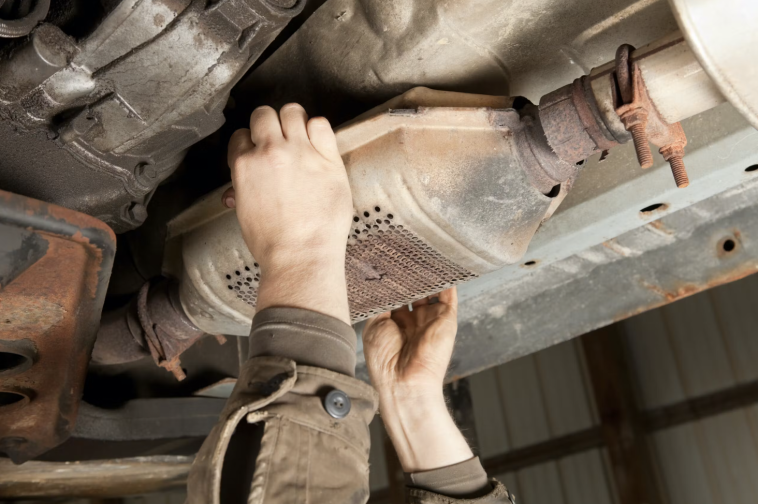Catalytic converters are number four on the list of most stolen car items in the United States behind tires, truck tailagates, and batteries. But why? Catalytic converters are valuable due to the amount of precious metals they contain- which is why many auto recycling companies such as Core Masters buy junk or totaled cars in an effort to remove and recycle them. But what happens when a catalytic converter is removed from a drivable car, or maybe even at the hands of theft?
The catalytic converter is an essential component in your vehicle that converts most toxic gasses produced as a byproduct of combustion into non-toxic gasses, essentially acting as a filter for the exhaust system. Removing the catalytic converter might seem safe, but attempting to remove the converter on your own can be dangerous in more ways than one. We’ll review the catalytic converter’s function in a car and why removing it isn’t as simple as you might assume.
What Does the Catalytic Converter Do?
The catalytic converter is a honeycomb-like component of your exhaust system that filters poisonous substances in the exhaust gas and breaks them down into less toxic compounds. Catalyzing a redox reaction through the palladium, rhodium, and platinum coating reduces pollutants such as nitrogen gas, carbon monoxide, nitrogen oxide, and hydrocarbon by up to 90%. Instead, carbon dioxide and water are expelled. Carbon dioxide is still toxic, but not to the same extent.
Why Is It Dangerous to Remove a Catalytic Converter?
Removing a catalytic converter comes with a degree of risk, and our above explanation of catalytic converters segues nicely into our first point.
Legality
By law, combustion engine vehicles must have a catalytic converter. Without it, a car’s emissions will supersede regulatory emissions standards set by the EPA. Aftermarket exhausts that mimic catalytic converters, sometimes called “fake cats,” are also illegal, as they do not regulate emissions. The only exceptions are cars made before 1975, at which point catalytic converters were neither commonplace nor required by law.
In some states, such as California, car owners must provide a valid reason to replace their catalytic converters. In most cases, if your car fails a state or federal emissions test, you can legally replace the catalytic converter; however, you must still provide documentation during the replacement process by identifying what’s wrong with the old one. Under federal law, you cannot replace a functional catalytic converter.
As you take it apart, it’s wise to record your findings and identify what’s wrong for legal purposes. For the layperson, these problems may not be easy to identify, so it’s usually best to leave removing and recycling the old catalytic converter to the professionals.
Remember, you can’t remove the converter and wait to install the new one; you cannot legally drive without a catalytic converter. Instead, you’ll need to have the new one installed right away. The newly installed part must meet the standards of the original manufacturer. As long as the aftermarket part conforms, it’s legal to install on your car.
From this information, you can readily see why leaving your catalytic converter replacement to the professionals is preferable. A catalytic converter recycling company or a mechanic specializing in exhaust systems can make sure you’re on the right side of the law when it comes to replacing this crucial part.
Ethicality
It’s difficult to understate just how toxic unfiltered exhaust fumes are. Carbon dioxide, the filtered product of a catalytic converter, is bad enough, but without the converter, the compounds created are poisonous and toxic to people’s lungs. Churning out a few extra horsepower isn’t worth the moral and ethical implications of driving without a cat.
The check engine light will persistently remind you that you’re driving illegally and contributing much more to pollution.
Fines
Removing a catalytic converter can result in a fine of up to $10,000. Sure, some people might get away with removing their converter, but it’s certainly not worth the risk of paying such an exorbitant amount. The police might be more inclined to pull a car over if it’s making excessive exhaust noises—which it will be if the cat is removed, potentially leading to a fine.
In some states, authorities may suspend your smog certification if you’re caught driving without a catalytic converter. Smog tests are required in some states every two years, but not all states require them.
If your car does not pass, you cannot legally drive or renew your registration. You will need to make necessary repairs if your car fails a smog test. If you removed the catalytic converter, then—surprise, surprise—you will need to replace it.
Difficulty
Replacing a catalytic converter by yourself is challenging for the reasons mentioned above. It’s not like replacing a tire, wherein you can change it whenever you like for whatever reason; a catalytic converter must, under federal law, be demonstrably faulty.
You can, however, replace the converter yourself if you have mechanical experience and can replace the converter directly. The catalytic converter may be either bolted on or installed directly into the exhaust manifold. Don’t forget: you’ll need to directly replace your catalytic converter with something that meets the original manufacturer’s recommendations or an aftermarket part that does the same.
Replacing Your Catalytic Converter
You have several options if you have a legitimate reason to replace a catalytic converter. First, you can consult a trusted local mechanic, preferably one specializing in exhaust systems, to see how much they charge for catalytic converter repair or replacement.
Consider looking into catalytic converter recycling companies, which simplify the process of buying a new converter and recycling your old one. First, you’ll purchase a catalytic converter, remove the original one, and install the new one. Then, you’ll ship the old catalytic converter for free to the recycling company, which will provide you compensation through a refund on your purchase.
The recycling company will reclaim the precious metals used in the catalytic converter to manufacture new ones. As such, you can contribute to global efforts toward recycling while also getting some compensation for your old converter.
The Bottom Line
Catalytic converters are essential, if not for the function of the car, then for the betterment of humanity. Removing a catalytic converter is illegal, as is driving without one, and those caught without one may face high fines and have their smog certification suspended. If you need to replace your catalytic converter, it’s best to consult a trusted mechanic or a catalytic converter recycling company to do so safely, ethically, and legally.




